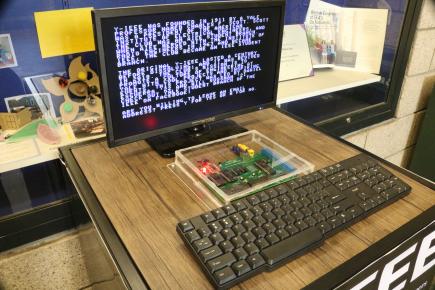With Apple I Replica, Y-IEEE Harkens To Earlier Digital Age

If you’ve recently passed through Becton outside the Center for Engineering, Innovation & Design (CEID), you’ve likely seen what looks like a very old computer (or if you’re not up on your computer history, a keyboard hooked up to a small TV).
It’s actually a replica of the Apple I, the very first product from the computer giant. It’s a project led by William Sussman ‘21 and Daniel Esguerra ’22, members of Y-IEEE, the Yale student branch of the Institute of Electrical and Electronics Engineers (IEEE). Just like the original Apple I, the Y-IEEE replica runs BASIC, a programming language that was popular in the 1970s.
In 1975, with the proceeds from selling off a VW van and a calculator, Steve Wozniak and Steve Jobs made computer history. Wozniak designed the computer and Jobs proposed selling empty circuit boards with Wozniak’s design so people could build it themselves. With the Apple I replica, Sussman and Esguerra bring us back to those heady days of a new digital era.
“The concept was that, if in 1975, the ‘Steves’ could go into a parts store and buy everything they needed to build their own computer, then we can definitely do the same thing today,” Sussman said.
It was an ambitious undertaking, since neither had ever built a computer from the ground up before.
“I’ve only assembled computers, but that’s much simpler because it’s only putting parts together,” Esguerra said. The Apple I replica, on the other hand, was built from scratch, including hand-soldering the board. “Everything they would have to do in the ‘70s, we did.”

It’s an interactive bit of technology history. Passersby can operate the computer themselves, respond to its prompts, play retro video games, and enter their email addresses for more information about the project. Sussman and Esguerra designed the replica to give users a “glimpse into the past” and a real feel of what it was like to use home computers back when they were still a rarity.
Although it’s currently located in Becton, they plan to display the computer in various other parts of campus. It’s a way of getting people talking. Other Y-IEEE projects include an extensible LED jumbotron and a scratch ham radio network.
“The broader vision of the club is to get people excited about this kind of stuff,” Sussman said. “Having it just spontaneously appear in the middle of the nave of Sterling or random other places on campus would be a way to get people excited about not just the state of technology as it is, but the history leading up to it - and engineering in general.”

